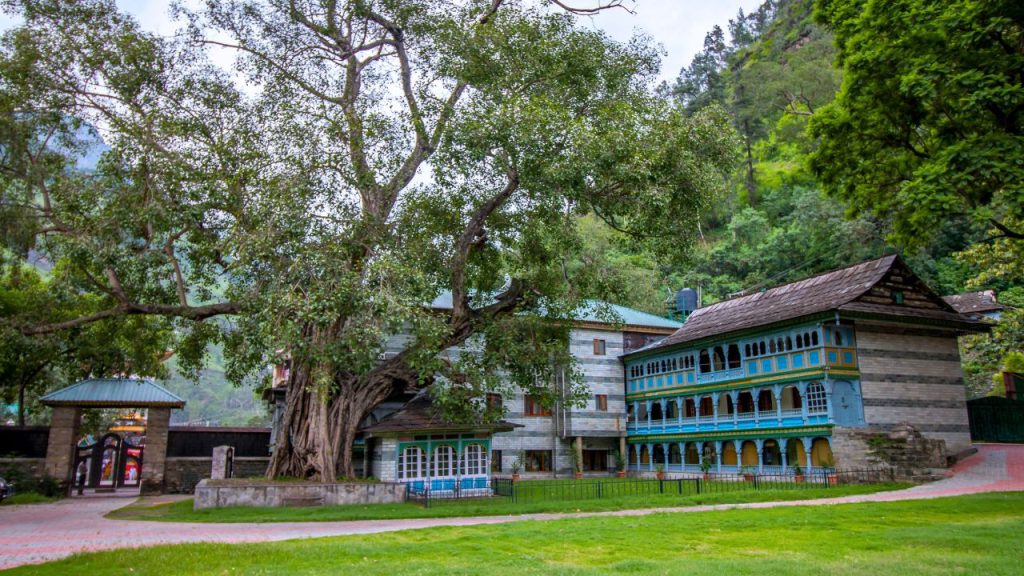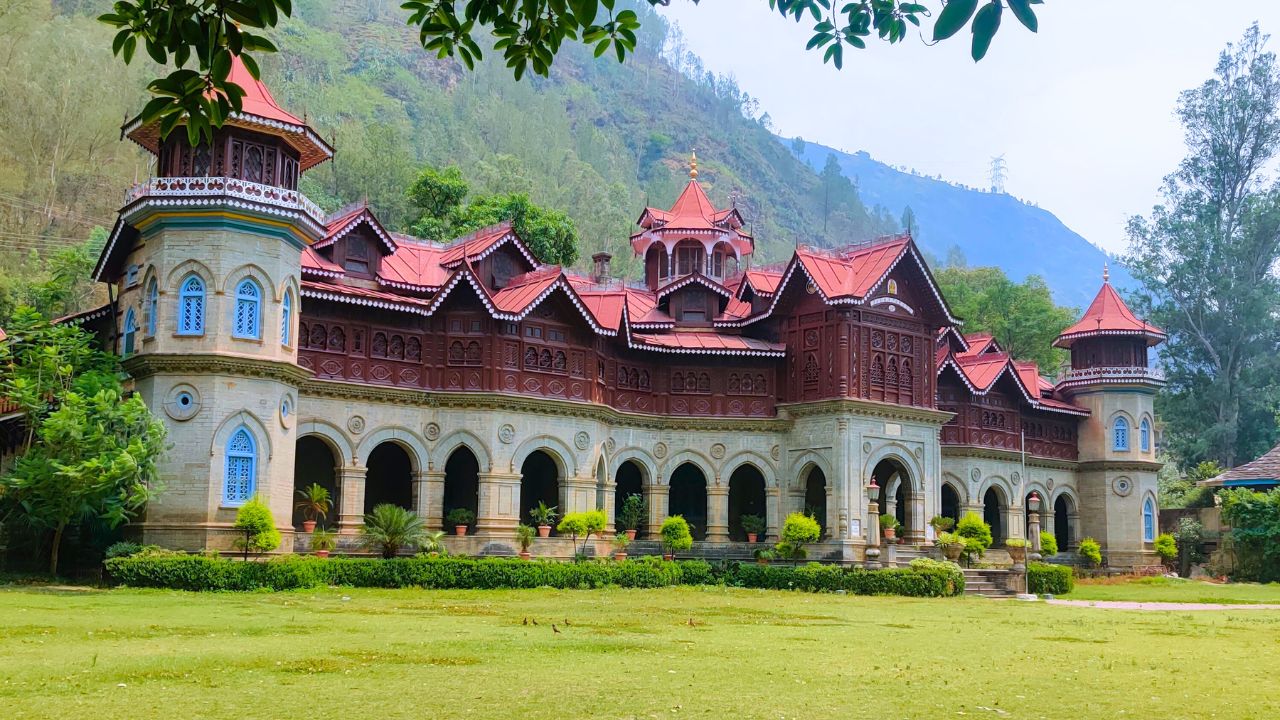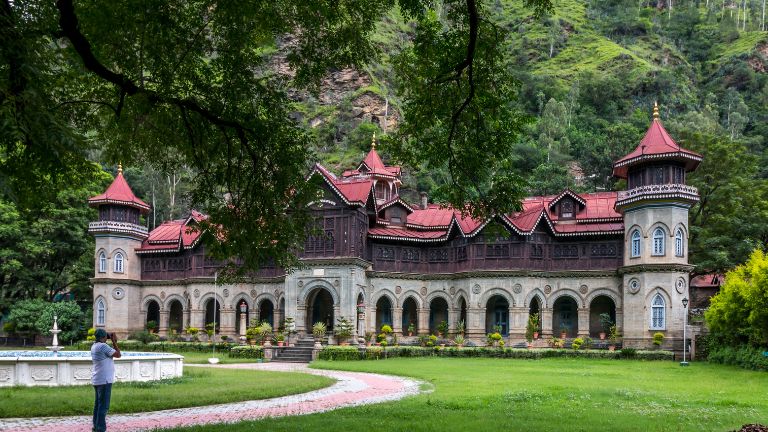The final capital of the Bushahr dynasty was the town of Rampur Bushahr, which is located 128 kilometers from Shimla where Padam Palace Rampur was built. Originally, the Bashar dynasty ruled the Kinnaur and Shimla regions from Kamru Fort, which is close to Sangla. Later, along the lovely River Sutlej, they relocated their base to Sarahan and then, a century later, to Rampur Bushahr.
It’s interesting to note that, according to mythology and legend, the dynasty has roots in the household of Lord Krishna. And the presence of numerous temples in the area confirms this belief. The mountain slopes are covered longitudinally by Rampur Bushahr. The River Sutlej is gushing below the entrance, guarded by an idol of Lord Hanuman from the Shimla side. The community appears to be fortunate and quite prosperous.
- The Padam Palace Rampur is a gateway to a bygone era of royalty.
- Padam Palace's History
- Planning And Design Of The Palace Complex
- Palace's Architectural Design
- The Building Of The Palace
- The Palace's Interiors
- Palace's Architectural Details
- Architectural structures of the palace:
- How to Reach Padam Palace Rampur Bushahr
- When to go to Rampur Bushahr?
- Do's and Don'ts
- Conclusion
- F&Q's Padam Palace Rampur
The Padam Palace Rampur is a gateway to a bygone era of royalty.

The Padam Palace is a regal structure that dominates the town’s center and is the only place where it will be found. Bypassing the historic Nau Nabh hotel, which is also a part of the palace complex, you can enter the palace through its large gate. The palace looks more magnificent because a large lawn is covered in greenery.
Padam Palace’s History

The walled, exalted Padam Palace is located in the city’s center, close to the bus station, and right next to the Nau Nabh heritage hotel. Formerly the winter capital of the princely state of Bushair, the Palace and town are now just the royal family’s and Chief Minister Virbhadra Singh’s private homes.
Raja Padam Singh, the father of Virbhadra Singh and the 122nd King in the Bushahr dynasty, laid the cornerstone for Padam Palace in 1919. The building process took six years, and it was finished in 1925.
Planning And Design Of The Palace Complex
The Padam Palace, a heritage hotel, and worker’s quarters are just a few of the many structures that make up the enormous complex.
The main palace structure is square with a courtyard layout but is hidden from the outside. Both inside and outside the palace area, the Palace has a verdant green lawn. A water fountain can be found right in front of the palace building on the spacious outdoor lawn. The back of the Palace is surrounded by tall hills that offer stunning views.
Palace’s Architectural Design

The Padam location’s architecture is similar to Indo-Saracenic architecture, primarily a revivalist style used by the British raj in India. British architects created palaces for princely state rulers along parallel lines in colonial times. The facade’s series of arches and the cornice details are reminiscent of Indo-Saracenic architecture.
The Building Of The Palace
The fact that this Padam Palace Rampur is constructed over a 6-year period (between 1919 and 1925), as per the sources, highlights the amazing work the artisans performed that long ago. The majority of the structural components of the Palace are made of stone, which was quarried in a nearby area called Khaneri. The use of black gramme paste to cement stones will astound you. Wood, which is used in the Palace more frequently than stone, was taken from the nearby village of Munish’s jungle.
In terms of the stability of the structure, the continuous arch gallery on the ground floor makes it more stable, and the magnificent wooden work makes it light and bearable.
The Palace’s Interiors

Sadly, I could not see the Palace’s interiors because entering the Palace requires permission from the appropriate authorities since it is private property. According to the area, the Palace includes lavish rooms, a library, large halls filled with antiques, painted portraits of royal family members hung on the walls, and priceless antique furniture.
I also tried peeing through the tinted glass door, but all I could make out was a large hall with only a few pieces of furniture and an identical door on the opposite walls. When light entered the rooms through the tinted glass on the doors, it worked its magic.
Palace’s Architectural Details

A) That Turquoise-Blue Door
This seductive turquoise-blue wooden door is the palace’s main draw. This is one of the most fantastic door designs I have ever seen, with intricate wooden geometrical carving and mirror work against the tinted glass, making it feel like a door to heaven. The joinery detail in this palace is incredible, but I also noticed a door with a unique design. Like other doors, the main one is plain and white with a wooden pattern and stained glass work. The exterior wire mesh door is what distinguishes it. There are two flaps on this V-shaped door, and the top has a lovely cornice detail.
B) Another Unique Door
At the back of the palace, there is another special door. This door also has a blue paint job and lovely, brightly colored wooden carvings. On top of the door, there is a deer dummy with real horns. These horns, which were once used to symbolize the kings’ power through hunting and one of their pastimes, may have also been seen in other palaces.
Why is this door so unique? Hindu traditions dictate that during the festival of Holi, people also welcome the new month of Faag ( beginning of the spring season). There is a long-standing custom that the palace hosts a faag mela (faag fair), and many Devi and Devta idols (gods and goddesses) come to the palace to celebrate this festival. This is a good occasion for the locals in Rampur and the surrounding areas. The video below shows that Devi and Devtas celebrate Holi by dancing with colored powder. These days, many people travel from all over India to attend this fair because of its growing notoriety. There is a procession that moves through the area with loud drum rolls.
To the significance of the door, it is customary to use this door to welcome Devi & Devtas, that are invited to the Palace for the fair. From the same door, the royal family includes and reveres them. Additionally, a fair was held inside the Palace at that time, and the palace was open to all visitors.
C) Beautiful Wooden Elements And Carvings:

The palace’s upper facade covers intricate, dark brown wooden carvings. These carvings are simple or tinted glass, partially covered by geometric jaalis in various patterns.
Beautiful geometrical patterns painted in vivid colors and some mirror work decorate the corridor ceiling. Additionally, round flower stone motifs give the facade an extra touch of royalty.
Architectural structures of the palace:
The palace is a finely detailed work of architecture in terms of design and materials. Intricate and beautiful detailing of the palace.
Hertitage Hotel Nau Nabh

Macchkandi

A heritage hotel is located in a corner of the Padam palace, and is the property of the erstwhile rulers of Bushahr State. It stands in Hardwar Palace. This hotel is 4 star rated and is a private property of Raja Virbhadra Singh. This hotel is new addition to the palace complex but hotel’s some part is old one but the main hotel building seems new. The hotel consists of restaurant where tourist visiting the Padam Palace can have good food. Hotel also consists of luxury rooms where you can feel like king and queen itself. The hotel has a courtyard with beautiful wooden work and different motif art.

The carving were painted in different colours but also have mirror work on it (because of which it is also known as ‘Sheesh Mahal’ means crystal palace). The different motifs or flower, fish etc that is used as pattern base for this dome. Also Om, Ram and name of the king has been engraved on the dome. There is a view in all eight directions and a view from this structure of the palace is superb.
Palace Building

After stepping out of Macchkandi, came the grand palace. I couldn’t take my eyes off this marvelous piece after staring for a while. The palace have the subtle earthy colors which blend with the surroundings so well. The palace stand strong and has a symmetrical facade and the series of arches and a huge portico in the front make it grand. Also the two towers in the end of the facade add that royal castle touch to the whole design. The dark brown painted wooden work depicts the amazing craftsmanship and the interesting roof design in the red color sits like a crown at the top.
The other buildings of the palace complex

At the rear of the palace complex to the left there are some buildings which are part of the complex. These buildings belong to the darbari’s (people who worked for kings eg: clerks, advisors and servants etc) with their families. These buildings were made in stone with red roofs and simple joinery that were minimum amount of detailings.
How to Reach Padam Palace Rampur Bushahr
Padam Palace is just 128 kilometers away from Shimla, making it an easy 3-hour journey by bus, cab, or private car. If you’re traveling by bus, simply hop off at the nearest bus stand and take a short stroll just a few meters to the right and you’ll find yourself standing before the majestic Padam Palace.
Accessibility to transportation
- There is no airport facility (there is no nearby air service available)
- Bus service: Many buses travel between Delhi and Rampur.
- Taxi service: A taxi service is also easily accessible.
Below is a list of the distance by road:
- About 470 kilometers from Delhi (via NH-44 and NH-5, approx. time-11 to 12 hours)
- About 126.4 kilometers from Shimla (via NH-5, approx. time-3 to 4 hours)
The Padam Palace’s outdoor areas are free to visit, but you must obtain permission in advance to enter the building’s interior.
When to go to Rampur Bushahr?

Rampur Bushahr is accessible all year. The pleasant summer months of March through June. The monsoon season begins in June and lasts through September. It’s cold, but a good time to explore the area is from September to November. Rampur experiences chilly, snowy winters from December to March. Before making travel arrangements, check the status; sometimes, roads get close.
However, the Lavi festival, which takes place annually between November 11 and 14, is the ideal time to visit the city. One of the largest fairs in North India is Lavi Fair. It breathes new life into the community and is widely talked about.
That concludes our discussion of Rampur, A Door to Timeless Royalty, and the Padam Palace. Going to Padam Palace was like traveling back in time to the Royal Raj, when they ruled and made crucial decisions for their subjects. The locals still greet Raja Virbhadra Singh (the current king) with the same respect as they would a local king.
Do’s and Don’ts
Admission Policy
- The palace is closed to the public at all times. Please ensure clearance before you enter.
- Seek advice from your local tourism bureau or ask around among the local folk.
Prepare In Advance
- You are well-advised to contact with the caretaker or a local guide for interior inspections.
Choose Transportation Conveniently
- Closest big town: Shimla (130 km)
- Straightforward road connection along NH-5. Regular HRTC buses.
Take Pictures of The Exteriors
- Nice woodwork, balconies, and European-Himachali architecture.
- Photography is good early morning or late afternoon.
Eat Local Cuisine
- The must-try dishes : Morsu, Chana, Bhuna Gosht
- Have a meal ramming in the small streets of the town or at nearby dhabas.
Accommodation Advice
- Stay in Rampur, if you want the experience of local culture (with budget options).
- Stay in Narkanda or Shimla if you would rather live comfortably or offer a convenient base for day trips.
Paying Respect to Local Culture
- You have to dress simply, and be polite.
Conclusion
It is also a museum with artifacts from those earlier times and serves as an archive for local history. This grand palace reflects an epoch of life as princely as it was cultured, and reflects the wealthy heritage of Himachal Pradesh. Whether describing Raja Padam Singh’s original intentions or the architectural form represented by its all-deodar wood interior, practically every single inch is a book in itself crying out to be read.
On the one hand the Palace takes the place of a monopoly on heritage sites in Rampur, providing an opportunity not just to understand its lengthy history but also take in surrounding parks and cultural activities. For the avid inquirer or art devotee, visiting Padam Palace Rampur should prove a new and exhilarating experience.
F&Q’s Padam Palace Rampur
Who made Padam Palace?
One of the most popular attractions in Shimla’s Rampur Bushahr is the Padam Palace. It was once the winter capital of Bushair, a former princely state. In 1919, Raja Padam Singh laid the palace’s foundation on the Satluj River’s left bank.
Who is the king of Rampur Bushahr?
Since 1947, Raja Vibhadra Singh has ruled over Rampur-Bashahr. 13-Jul-2021
Who was the founder of Princely State Bushahr?
C. F. Kennedy claims that Rana Danbar Singh, a Rajput immigrant from the Deccan, founded it in 1412.
Who is the owner of Padam Palace Rampur Bushahr?
Raja Vikramaditya Singh(Tikka Sahib), owns the current Padam Palace in Rampur Bushahr.
Who is the Current king of Princely State Bushahr?
Raja Vikramaditya Singh, is the current titular king of the former princely state of Bushahr.
When Padam Palace was Built?
Padam Palace was built between 1919 and 1925 by Raja Padam Singh of Bushahr








